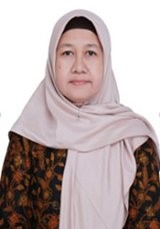Activity and Stability Test of Lip Balm Preparation Formulation from Ethanol Extract of Kersen Leaves (Muntingia calabura L.) as Sunscreen
Uji Aktivitas dan Stabilitas Formulasi Sediaan Lip Balm Ekstrak Etanol Daun Kersen (Muntingia calabura L.) sebagai Tabir Surya
Downloads
Sunscreen was a cosmetic product that could chemically or physically inhibit the penetration of ultraviolet (UV) rays into the skin. One of the medicinal plants with notable sun protection properties was the leaf cherry (Muntingia calabura L.). The total flavonoid and phenolic content of cherry leaves possess unique antioxidants that helped protect the skin from damage caused by sun exposure. This study aimed to evaluate the stability and antioxidant activity of the lip balm extract from cherry leaves (Muntingia calabura L.) at concentrations of 0%, 4%, 6%, and 8%. This research employed an experimental design with four different concentrations: 0%, 4%, 6%, and 8%. Antioxidant testing was conducted using the DPPH method (2, 2-diphenyl-1-picrylhydrazyl), alongside sunscreen activity tests and stability assessments over 28 days at room temperature. The results from the antioxidant testing of the cherry leaf extract lip balm formulation indicated robust antioxidant activity, with an IC50 value showing that at a concentration of 4%, the initial value was 2.12 mg/L and the final value was 2.10 mg/L; at 6% concentration, the initial value was 1.11 mg/L and the final value was 1.13 mg/L; and at 8%, the values should be assessed. The ultra category SPF value was noted at a concentration of 8%, with an initial value of 45.93 and a final value of 33.69. Thus, it was concluded that the cherry leaf extract lip balm preparation had good antioxidant and SPF properties.
Keywords: lip balm, cherry leaf extract, sunscreen
Aidina, S. (2020) Formula dan Aktivitas Antioksidan Sediaan Lip Balm yang diperkaya Ekstrak Daun Bidara (Ziziphus spina-christi L.), Skripsi. Universitas Islam Negeri Syarif Hidayatullah Jakarta.
Ambari, Y. et al. (2020) ‘Studi Formulasi Sediaan Lip Balm Ekstrak Kayu Secang (Caesalpinia sappan L.) dengan Variasi Beeswax’, Journal of Islamic Pharmacy, 5(2), pp. 1–10.
Aprilia, R.D., Purwantiningrum, H. and Tivani, I. (2023) ‘Uji Sifat Fisik Dan Stabilitas Sediaan Lip Balm Dari Ekstrak Bekatul Padi (Oryza sativa)’, Doctoral dissertation, Politeknik Harapan Bersama.
Azalia, D. et al. (2023) ‘Uji Kualitatif Senyawa Aktif Flavonoid Dan Terpenoid Pada Beberapa Jenis Tumbuhan Fabaceae Dan Apocynaceae Di Kawasan TNGPP Bodogol’, BIOMA: Jurnal Biologi Makassar, 8(1), pp. 32–33.
Azzahra, H.N. (2024) ‘Formulasi Sediaan Lip Balm Menggunakan Ekstrak Anggur Laut (Caulerpa racemosa (Forsskål) J. Agardh) Sebagai Tabir Surya’.
Cahyani, S., Rusydi Hashim, S.H. and Pramestyani, E.D. (2024) ‘Formulasi Lip Balm dan Penetapan SPF (Sun Protection Factor) Ekstrak Daun Mangga’, Majalah Farmasetika, 9(2), p. 140.
Dayanti, E.W. et al. (2021) ‘Efektivitas Kitosan Dari Limbah Kulit Udang Terhadap Angiogenesis dalam Penyembuhan Luka Eksisi pada Tikus Putih (Rattus norvegicus) Jantan’, Media Kedokteran Hewan, 32(2), p. 60.
Dominica, D. et al. (2023) ‘Formulasi Pelembab Bibir Alami Dari Sari Buah Jeruk Kalamansi (Citrofortunella microcarpa) Dan Ekstrak Bunga Rosella (Hibiscus sabdariffa)’, Journal of Pharmaceutical and Sciences, 6(1), pp. 26–36.
Draelos, Z.D. and Thaman, L.A. (2006) Cosmetic Formulation of Skin Care Products. New York: Taylor and Francis Group.
Dutra, E.A. et al. (2004) ‘Determination of sun protection factor (SPF) of sunscreens by ultraviolet spectrophotometry’, Revista Brasileira de Ciências Farmacêuticas/Brazilian Journal of Pharmaceutical Sciences, 40(3), pp. 381–385.
Hanum, C.F., Anastasia, D.S. and Desnita, R. (2021) ‘Formulasi dan Evaluasi Sediaan Lip Balm Avocado Sebagai Pelembab Bibir’, Jurnal Mahasiswa Farmasi Fakultas Kedokteran UNTAN, 5(1), pp. 4–16.
Hasanah, S.S. (2020) Uji Aktivitas Antioksidan serta Penentuan Nilai SPF (Sun Protection Factor) pada Formula Lip Balm Bunga Rosella (Hibiscus sabdariffa L.), Skripsi. Digital Repository Universitas Jaber.
Iflahah, M.A., Puspawati, N.M. and Suaniti, N.M. (2016) ‘Aktivitas Antioksidan Biji Kakao (Theobroma cacao L.) Dalam Menurunkan Kadar 8-Hidroksi-2′-Deoksiguanosin’, Indonesian E-Journal of Applied Chemistry, 4(2), pp. 113–119.
Islamiah, N.F., Sukrasno and Simanullang, G. (2023) ‘Formulasi dan Evaluasi Stabilitas Fisik Sediaan Lip Balm Minyak Bekatul (Rice Bran Oil)’, Media Farmasi Indonesia, 18(2).
Khaleeda, N. et al. (2022) ‘In Vitro Anti-Diabetic Activities and UHPLC-ESI-MS/MS Profile of Muntingia calabura Leaves Extract’, Molecules, 27, pp. 1–21.
Kusriani, H., Marliani, L. and Apriliani, E. (2017) ‘Aktivitas Antioksidan dan Tabir Surya dari Tongkol dan Rambut Jagung (Zea mays L.)’, Indonesian Journal of Pharmaceutical Science and Technology, 4(1), p. 10.
Muflihunna, A. and Mu’nisa, A. (2023) ‘Analisis Antioksidan Terhadap Fotoprotektif Kulit Dari Beberapa Jenis Tanaman’, 23(2018), p. 2023.
Pambudi, D.B. et al. (2021) ‘Aktivitas Antioksidan Ekstrak Daun Kersen (Muntingia calabura L.) dengan Menggunakan Metode DPPH’, Prosiding University Research Colloquium, pp. 979–985.
Samodra, G., Alfathani, N.F. and Octaviani, P. (2023) ‘Uji Aktivitas Antioksidan Ekstrak Etanol Kombinasi Daun Kersen (Muntingia calabura L.) dan Daun Kelor (Moringa oleifera L.) dengan Metode DPPH (2,2-Diphenyl-1-Picrylhydrayl)’, Pharmacon: Jurnal Farmasi Indonesia, 20(1), pp. 19–26.
Sari, R.M. (2021) ‘Formulasi dan Uji Sifat Fisik Lip Balm Ekstrak Etanol Buah Strawberry (Fragaria sp.)’, Journal of Pharmacy Tiara Bunda, 1(09), pp. 8–15.
Smaoui, S. et al. (2017) ‘Development and stability studies of sunscreen cream formulations containing three photo-protective filters’, Arabian Journal of Chemistry, 10, pp. S1216–S1222.
Supartiningsih, S. et al. (2021) ‘Formulasi Sediaan Pembuatan Pelembab Bibir (Lip Balm) Menggunakan Sari Buah Pepaya (Carica papaya L.)’, Jurnal Farmanesia, 8(2), pp. 107–112.
Utama, V.K., Islam, D. and Sundary, N. (2023) ‘Formulasi dan Evaluasi Sediaan Pelembab Bibir (Lip Balm) Menggunakan Ekstrak Kulit Nanas (Ananas comosus L. Merr.)’, Jurnal Ilmu Kesehatan Abdurrab, 1(3), pp. 5–6.
Widjaya, S., Bodhi, W. and Yudistira, A. (2019) ‘Skrining Fitokimia, Uji Aktivitas Antioksidan, dan Toksisitas dari Ekstrak Daun Kersen (Muntingia calabura L.) dengan Metode 1,1-diphenyl-2-picrylhydrazyl (DPPH) dan Brine Shrimp Lethality Test (BSLT)’, Pharmacon, 8(2), p. 315.
Wijaya, L.R. and Safitri, C.I.N.H. (2020) ‘Uji Aktivitas Formulasi Lip Balm dari Ekstrak Bekatul Padi (Oryza sativa) Sebagai Tabir Surya’, Prosiding SNPBS (Seminar Nasional Pendidikan Biologi dan Saintek), 5, pp. 276–283.
Wimpy, Harningsih, T. and Larassati, W. (2020) ‘Uji Aktivitas Antioksidan dan Tabir Surya Kombinasi Ekstrak Kulit Buah Pisang Kepok (Musa paradisiaca Linn) dan Ekstrak Kulit Buah Alpukat (Persea americana Mill)’, Jurnal Ilmiah Manuntung, 6(2), pp. 231–239.
Yadav, A. et al. (2020) ‘Formulation and Evaluation of Herbal Lipbalm from Amaranth Leaf Colour Pigment’, International Journal for Research in Applied Science and Engineering Technology, 8(6), pp. 653–662.
Yuliatika, K. et al. (2023) ‘Formulasi Sediaan Lip Balm Ekstrak Etanol Kulit Buah Pisang Raja (Musa paradisiaca sapientum) Sebagai Antioksidan’, Pharmacia, 2(3), pp. 145–161.
Copyright (c) 2025 Evanisia More, Chendra Yunike Sui, Magi Melia Tanggu Rame

This work is licensed under a Creative Commons Attribution-ShareAlike 4.0 International License.
BIKF by Unair is licensed under a Creative Commons Attribution-ShareAlike 4.0 International License.
1. The journal allows the author to hold the copyright of the article without restrictions.
2. The journal allows the author(s) to retain publishing rights without restrictions
3. The legal formal aspect of journal publication accessibility refers to Creative Commons Attribution Share-Alike (CC BY-SA).
4. The Creative Commons Attribution Share-Alike (CC BY-SA) license allows re-distribution and re-use of a licensed work on the conditions that the creator is appropriately credited and that any derivative work is made available under "the same, similar or a compatible license”. Other than the conditions mentioned above, the editorial board is not responsible for copyright violation.























